Man-made lakes, loved by humans, can harm the environment
In a photo taken in 2017 -- the Columbia Dam before demolition was 18 feet high and 330 feet wide. PHOTO BY MEG McGUIRE
Taken in summer 2017, here's the "lake" above the Columbia Dam on the Paulins Kill before the dam was removed. Notice how the marsh grasses are growing into what environmentalists call an impoundment, stressing the non-natural creation of the lake. PHOTO BY MEG MCGUIRE
Taken in 2017, the busy intersections that cross at the entrance to the Columbia Wildlife Management Area — hard to imagine how peaceful it is just 50 yards down the dirt road. PHOTO BY MEG McGUIRE
BEAVERS AND HUMANS are fond of damming rivers.
Some dams are welcomed by their various owners, some less so. Some dams provide hydroelectric power. Some man-made lakes supplied ice before we had refrigeration. Some were created for housing (by beavers) and others were created (by humans) as an attraction for housing development. We do love our lakes, man-made or not, as you can see by the houses clustered near any lake's edge in communities all over the Delaware watershed.
Sometimes, though, different people can think different things about the same dam.
Take the Columbia Dam on the Paulins Kill, one of the significant tributaries of the Delaware River, flowing east to west in northern New Jersey. The dam is about a quarter mile from the Delaware and just south of the Delaware Water Gap.
Many environmentalists worry about dams' effect on the local environment, since dams will change that environment.
Local people, long used to the changed environment (many dams have been around for a hundred years or more) aren't so enthusiastic about changing something that isn't broken, at least from their point of view.
What's broken, the environmentalists counter, is the river itself.
The Nature Conservancy did a review of dams in the northeast, evaluating which dams most affect the "connectivity" of a river. Out of 14,000 dams, a few made it into projects that The Nature Conservancy wanted to tackle. The Paulins Kill was one of them.
"We've been working in the Paulins Kill watershed for about 10 years," said Barbara Brummer, the executive director of the New Jersey chapter of The Nature Conservancy. "The Paulins Kill is an important tributary of the Delaware, and this dam – the Columbia dam – lit up as an important dam.
"I wondered," said Brummer, "if we could take that dam down."
All dams need significant upkeep to remain safe. All dams interfere with the natural running of any river and all the aquatic life that depends on the river. For example, given clean water and free access, the American shad comes from the ocean all the way up to the shallow waters of the Upper Delaware to spawn. Environmentalists believe that the American shad would do that in any of the Delaware's tributaries, given the chance.
And that's what The Nature Conservancy of New Jersey and American Rivers are doing, giving the Paulins Kill a chance to return to its normal flow in its last few miles by taking down the Columbia Dam.
But the process to get to that "chance" is complicated. Since the Paulins Kill is in the Columbia Wildlife Management Area, its owner is the New Jersey Department of Environmental Protection. It had leased the dam and its hydroelectric facility to a private citizen. But the hydroelectric facility would need costly repairs to obtain its next license to operate from the Federal Energy Regulatory Commission, so the private citizen wasn't interested in renewing his license. Partly because of those costs, and the relatively small amount of electricity produced, NJDEP wanted to take the dam down.
So, NJDEP worked out a deal with The (NJ) Nature Conservancy, and the dam will be coming down in slow stages over this year, despite opposition from Knowlton Township locals.
That opposition is worth noting. The NJDEP may "own" the dam, but the people in Knowlton like to think of the dam as theirs. Locals refer to the body of water behind the dam as a lake. Environmentalists call it an impoundment, a term that emphasizes its non-natural roots.
Brummer respects local objections, "After all, we're coming from outside the community, aiming to change something they value."
Van Horn is one of those local environmentalists. He's been mayor of Knowlton and now serves on the town board. He calls himself and his fellow citizens "stewards of the environment."
He's careful about his farming practices. He's a fisherman and can wax quite rhapsodic about the energetic water that rushes from the dam to the Delaware. He feels that taking the dam away will change the landscape, and not for the better. He supports environmental organizations and really loves this area of the world.
What he says about the dam removal: "They're (the environmental groups) usually right about things, but they made a mistake on this one."
When the cost factors of repair, upkeep and insurance are mentioned, he counters with his own and his town's rejection of that way of looking at it. The hydroelectric power supplied by the dam brought money that could have paid for a fish ladder, and the dam itself, he says, has recently been given an A+ status for safety.
But the town neither owns nor operates the dam.
There have been, Brummer recounts, several public meetings to hear local concerns. There was even a non-binding referendum on the November 2016 ballot, and the dam removal did not get enthusiastic approval.
"Some people understood what we were doing and were OK with it," Brummer said. "Some did not."
So the arguments go back and forth, but the dam will be coming down. By mid-September, the the waters will be lowered by 7 feet, Brummer explained. The water in the lake/impoundment will come down slowly. If it's released too quickly, it would risk tearing down some of the banks of the river and that would add more silt to the river.
"Next year we'll start lowering the dam notch by notch. The timing is important to all the wildlife that use the river," she said.
The Columbia Dam when it has been raining is noisy and brimming over, splashing and forming an impressive waterfall about 18 feet high. The Paulins Kill narrows after the dam, rushing through a narrow defile to the Delaware.
The lake formed by the dam is many times wider than the dam itself, which is 330 feet.
The waters after the dam are lively, the waters before the dam (called Columbia Lake) are quite still, which is not the natural state of any river. The impoundment (or lake) is already showing signs of closing in on itself, as the marsh plants creep into the still water.
"The impoundment is eutrophying." said Brummer. "It's really not the best pond. It wants to be a river."
"A river is essentially a silt transportation vehicle," explained Beth Styler Barry, who is a river restoration manager with The Nature Conservancy. In a natural setting, water upstream washes silt downstream, eroding the sides and bottom of the river. That erosion is minimized by planting trees and other plants by the sides of the river to contain its appetite.

If there's a dam the water doesn't run as fast, and silt will fall where the water is slow, making the water more turbid and changing the shape of the river bottom. Also, slow moving water is warmer than fast moving water, and the broad expanse of a lake means that there is little shade making the water warmer still. Warm, slow water has less dissolved oxygen that fish need to thrive. Species like trout, for example, are very fussy about water and likely would not thrive in such water, but getting rid of the dam would make all the difference.
It's hard to figure out just where the "new" river will run once the lake has run out. Laura Craig from American Rivers is the project manager for the design and permitting phases of the project.
She said there is engineering work done to get a best estimate to see how the river will reconfigure itself, forming riffles and pools that are ideal habitat for "riverine critters."

Styler Barry from The Nature Conservancy is the boots on the ground and the project manager for the construction phase of the project. Before she was involved, Craig from American Rivers served as the project manager for the design and permitting phases of the project and providing scientific expertise related to dam removal, river restoration, and monitoring.
In fact, both organizations provide significant expertise in how rivers work, how dams interfere with how rivers are meant to work, and how to restore rivers to their natural state. In a project like this, there are a host of other organizations working together to restore the 41-mile river and its floodplain, like New Jersey Audubon and the Wallkill River Water Management Group and many more.
"Some of the locals said 'We won't have swans,' " Brummer said, "That's true. And you won't have big carp that like warm slow water.
"But you will have native shad and the wildlife that is natural to the river. I like to say that every spring the shad are bumping their noses at the dam."
When you travel farther upstream and stand on the Brugler Bridge and just beyond, you can see the Paulins Kill in its natural state, and that's what this project is aiming for downstream.
"It's going to be beautiful,' said Brummer. "They know this lake as as their lake but it really belongs to the whole watershed.
"This is a resource that belongs to everyone. By doing this we hope to make the watershed better for people overall."
There are more dams on the Paulins Kill, one of them is the next dam upstream in Blairstown, is already being considered by its owners, the town, to be breached to allow the river to flow freely. Further up is the Paulins Kill Lake dam in Stillwater, but there are no conversations about taking that dam down.
The different futures for these dams, and different opinions about keeping them or taking them down give some indication that there is no one-size-fits-all response to restoring rivers and making them healthy or keeping them that way.
Other Nature Conservancy projects in the Paulins Kill watershed:
• Floodplain Restoration (goal of planting 50,000 trees by 2020)
• Water Quality Monitoring (10 years)
• Bobcat Alley land protection (goal of 3,500 acres by 2020)
• Hyper Humus Wildlife Management Area restoration
Partners in the watershed restoration:
• NJDEP Division of Fish & Wildlife
• Academy of Natural Sciences of Drexel University, Philadelphia
• United States Geological Service





[…] Man-made lakes, loved by humans, can harm the environment – Delaware Currents […]